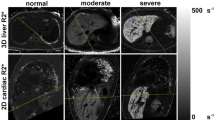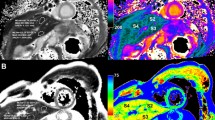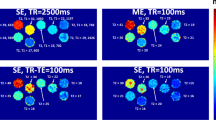Abstract
Purpose
The purpose of this study is determine if both liver T2* and cardiac T2* can be measured on a single breath-hold acquisition.
Materials and methods
For this IRB-approved retrospective study, 137 patients with dedicated Cardiac MRI and Liver MRI examinations obtained sequentially on 1.5T scanners and on the same day were included for analysis. Both the cardiac and liver MRI examinations utilized GRE sequences for quantification of tissue iron. Specifically, T2* was measured using an 8-echo, multi-echo gradient echo single breath-hold sequence. Liver T2* was measured in a blinded manner on images from each of the cardiac and dedicated liver MRI examinations and were correlated. Bland–Altman difference plot was used to assess mean bias.
Results
137 examinations from 93 subjects met inclusion criteria. 10 examination pairs were excluded because the first echo time (TE) on the cardiac MRI was insufficiently short for the very high liver iron content. After exclusion, 127 studies from 89 subjects (67.4% males) were included in the final analysis. The mean subject age (± standard deviation) was 11.5 ± 7.5 years (range 0–29.3 years; median 10.5 years). Mean liver T2* measured on cardiac MRI was 8.3 ± 7.7 ms and mean liver T2* measured on dedicated liver MRI was 7.8 ± 7.4 ms (p < 0.001). There was strong positive correlation between the two liver T2* measurements (r = 0.989, p < 0.0001; 95% CI 0.985–0.992). With the exception of borderline outliers, all values fell within two standard deviations on the Bland–Altman difference plots, with a mean bias of 0.5 ms (range − 1.8 to + 2.7 ms).
Conclusion
In most patients with suspected or known iron overload, a single breath-hold GRE sequence may be sufficient to evaluate the iron concentration (T2*) of both the myocardium and the liver.






Similar content being viewed by others
References
Lieu PT, Heiskala M, Peterson PA, Yang Y (2001) The roles of iron in health and disease. Mol Asp Med 22(1–2):1–87
Ware HM, Kwiatkowski JL (2013) Evaluation and treatment of transfusional iron overload in children. Pediatr Clin N Am 60(6):1393–1406
Regev A, Berho M, Jeffers LJ, et al. (2002) Sampling error and intraobserver variation in liver biopsy in patients with chronic HCV infection. Am J Gastroenterol 97(10):2614–2618
Towbin AJ, Serai SD, Podberesky DJ (2013) Magnetic resonance imaging of the pediatric liver: imaging of steatosis, iron deposition, and fibrosis. Magn Reson Imaging Clinics N Am 21(4):669–680
Serai SD, Fleck RJ, Quinn CT, Zhang B, Podberesky DJ (2015) Retrospective comparison of gradient recalled echo R2* and spin-echo R2 magnetic resonance analysis methods for estimating liver iron content in children and adolescents. Pediatr Radiol 45(11):1629–1634
Serai SD, Smith EA, Trout AT, Dillman JR (2017) Agreement between manual relaxometry and semi-automated scanner-based multi-echo Dixon technique for measuring liver T2* in a pediatric and young adult population. Pediatr Radiol 48:94–100
Wood JC, Zhang P, Rienhoff H, Abi-Saab W, Neufeld EJ (2015) Liver MRI is more precise than liver biopsy for assessing total body iron balance: a comparison of MRI relaxometry with simulated liver biopsy results. Magn Reson Imaging 33(6):761–767
Hankins JS, McCarville MB, Loeffler RB, et al. (2009) R2* magnetic resonance imaging of the liver in patients with iron overload. Blood 113(20):4853–4855
Sirlin CB, Reeder SB (2010) Magnetic resonance imaging quantification of liver iron. Magn Reson Imaging Clin N Am. 18(3):359–481, ix
Wood JC (2014) Use of magnetic resonance imaging to monitor iron overload. Hematol Oncol Clin N Am 28(4):747–764
Wood JC, Enriquez C, Ghugre N, et al. (2005) MRI R2 and R2* mapping accurately estimates hepatic iron concentration in transfusion-dependent thalassemia and sickle cell disease patients. Blood 106(4):1460–1465
Pepe A, Positano V, Santarelli MF, et al. (2006) Multislice multiecho T2* cardiovascular magnetic resonance for detection of the heterogeneous distribution of myocardial iron overload. JMRI 23(5):662–668
Positano V, Pepe A, Santarelli MF, et al. (2009) Multislice multiecho T2* cardiac magnetic resonance for the detection of heterogeneous myocardial iron distribution in thalassaemia patients. NMR Biomed 22(7):707–715
Alustiza JM, Emparanza JI, Castiella A, et al. (2015) Measurement of liver iron concentration by MRI is reproducible. Biomed Res Int 2015:294024
Brittenham GM, Cohen AR, McLaren CE, et al. (1993) Hepatic iron stores and plasma ferritin concentration in patients with sickle cell anemia and thalassemia major. Am J Hematol 42(1):81–85
Anderson LJ, Westwood MA, Holden S, et al. (2004) Myocardial iron clearance during reversal of siderotic cardiomyopathy with intravenous desferrioxamine: a prospective study using T2* cardiovascular magnetic resonance. Br J Haematol 127(3):348–355
Serai SD, Dillman JR, Trout AT (2017) Proton density fat fraction measurements at 1.5- and 3-T hepatic MR imaging: same-day agreement among readers and across two imager manufacturers. Radiology 284:244–254
Krafft AJ, Loeffler RB, Song R, et al. (2017) Quantitative ultrashort echo time imaging for assessment of massive iron overload at 1.5 and 3 Tesla. Magn Reson Med 78(5):1839–1851
Doyle EK, Toy K, Valdez B, et al. (2017) Ultra-short echo time images quantify high liver iron. Magn Reson Med 79:1579–1585
Roach DJ, Cremillieux Y, Fleck RJ, et al. (2016) Ultrashort echo-time magnetic resonance imaging is a sensitive method for the evaluation of early cystic fibrosis lung disease. Ann Am Thorac Soc 13:1923–1931
Serai SD, Laor T, Dwek JR, Zbojniewicz AM, Carl M (2014) Feasibility of ultrashort TE (UTE) imaging of children at 1.5 T. Pediatr Radiol 44(1):103–108
Azarkeivan A, Hashemieh M, Shirkavand A, Sheibani K (2016) Correlation between heart, liver and pancreas hemosiderosis measured by MRI T2* among thalassemia major patients from Iran. Arch Iran Med 19(2):96–100
Noetzli LJ, Papudesi J, Coates TD, Wood JC (2009) Pancreatic iron loading predicts cardiac iron loading in thalassemia major. Blood 114(19):4021–4026
Papakonstantinou O, Alexopoulou E, Economopoulos N, et al. (2009) Assessment of iron distribution between liver, spleen, pancreas, bone marrow, and myocardium by means of R2 relaxometry with MRI in patients with beta-thalassemia major. JMRI 29(4):853–859
Meloni A, Puliyel M, Pepe A, et al. (2014) Cardiac iron overload in sickle-cell disease. Am J Hematol 89(7):678–683
Author information
Authors and Affiliations
Corresponding author
Ethics declarations
Funding
No funding was received for this work.
Conflict of interest
None.
Ethical approval
All procedures performed in studies involving human participants were in accordance with the ethical standards of the institutional and/or national research committee and with the 1964 Helsinki declaration and its later amendments or comparable ethical standards.
Informed consent
This was an IRB-approved HIPAA-compliant retrospective study and the need for informed consent was waived by the IRB.
Rights and permissions
About this article
Cite this article
Serai, S.D., Trout, A.T., Fleck, R.J. et al. Measuring liver T2* and cardiac T2* in a single acquisition. Abdom Radiol 43, 2303–2308 (2018). https://doi.org/10.1007/s00261-018-1477-4
Published:
Issue Date:
DOI: https://doi.org/10.1007/s00261-018-1477-4




